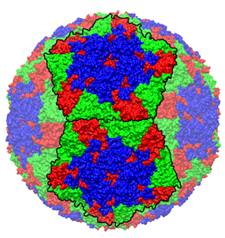Providing technology to help develop a new Foot and Mouth vaccine
Release Date 28 March 2013

Scientists at the University of Reading have provided underlying technology to allow the production of a new vaccine for foot-and-mouth disease virus (FMDV).
The new research, led by scientists from the Pirbright Institute and Diamond Light Source, represents a significant step forward in the global campaign to control FMDV in countries where the disease is endemic and could significantly reduce the threat to countries currently free of the disease.
The vaccine is all synthetic, made up of tiny protein shells designed to trigger an optimum immune response. Unlike the current vaccine it doesn't rely on growing live infectious virus so is much safer to produce. It is also easier to store than current vaccines, reducing the need for a distribution cold chain. Crucially, this new approach to vaccines could also impact on how viruses from the same family are fought, including polio.
Professor Ian Jones and his team in the School of Biological Sciences at the University of Reading created a form of the virus, made up of tiny empty shells, that looks exactly the same as the real virus but has no infection risk. Professor Jones said: "The shells have been altered to make them more stable and non-susceptible to the impact of warmer temperatures. The methodology used has succeeded in making this type of vaccine more efficient and reproducible for the first time.
"The new vaccine, which is not yet available in the marketplace, offers a number of advantages over the traditional vaccine; it is unable to initiate disease so there is no possibility of accidental release and it may be less susceptible to storage conditions meaning it could be stockpiled and used in rural communities more easily. As such it could offer a substantial benefit to animal health as far as control of FMDV is concerned."
The currently available vaccines are made from live virus so have an inherent risk of accidental release and are also relatively unstable, meaning that storage and use in rural locations, particularly tropical locations, is limited.
Dr Bryan Charleston, Head of Livestock Viral Diseases Programme at The Pirbright Institute said: "The FMDV epidemic in the UK in 2001 was disastrous and cost the economy billions of pounds in control measures and compensation. As a result of the outbreak the Royal Society recommended new approaches should be developed to control the virus should it happen again."
Professor David Stuart, Life Science Director at Diamond Light Source and MRC Professor of Structural Biology at the Department of Medicine, University of Oxford said: "What we have achieved here is close to the holy grail of foot-and-mouth vaccines. Unlike the traditional vaccines, there is no chance that the empty shell vaccine could revert to an infectious form. This work will have a broad and enduring impact on vaccine development, and the technology should be transferable to other viruses from the same family, such as poliovirus and hand foot and mouth disease, a human virus which is currently endemic in South-East Asia.
"Instead of using infectious virus as the basis for the vaccine, which is the main traditional method of vaccine development, the team using a methodology developed by Professor Ian Jones from the University of Reading synthetically created empty protein shells to imitate the protein coat that forms the strong outer layer of the virus."
The University of Reading has a long history of working on the molecular aspects of viruses, manipulating them to make new advances in the treatments of virus infections. This collaborative research was carried out by a UK partnership between The Pirbright Institute, Diamond Light Source, the UK's national synchrotron facility, the University of Reading and the University of Oxford.
Professor Jones said: "Increasingly in science, breakthroughs require the concerted action of a number of separate disciplines which together achieve results that could not be achieved by any one group alone."
ENDS
Notes for Editors
Image caption: Food and Mouth Disease virus - empty shell vaccine structure, copyright Oxford University